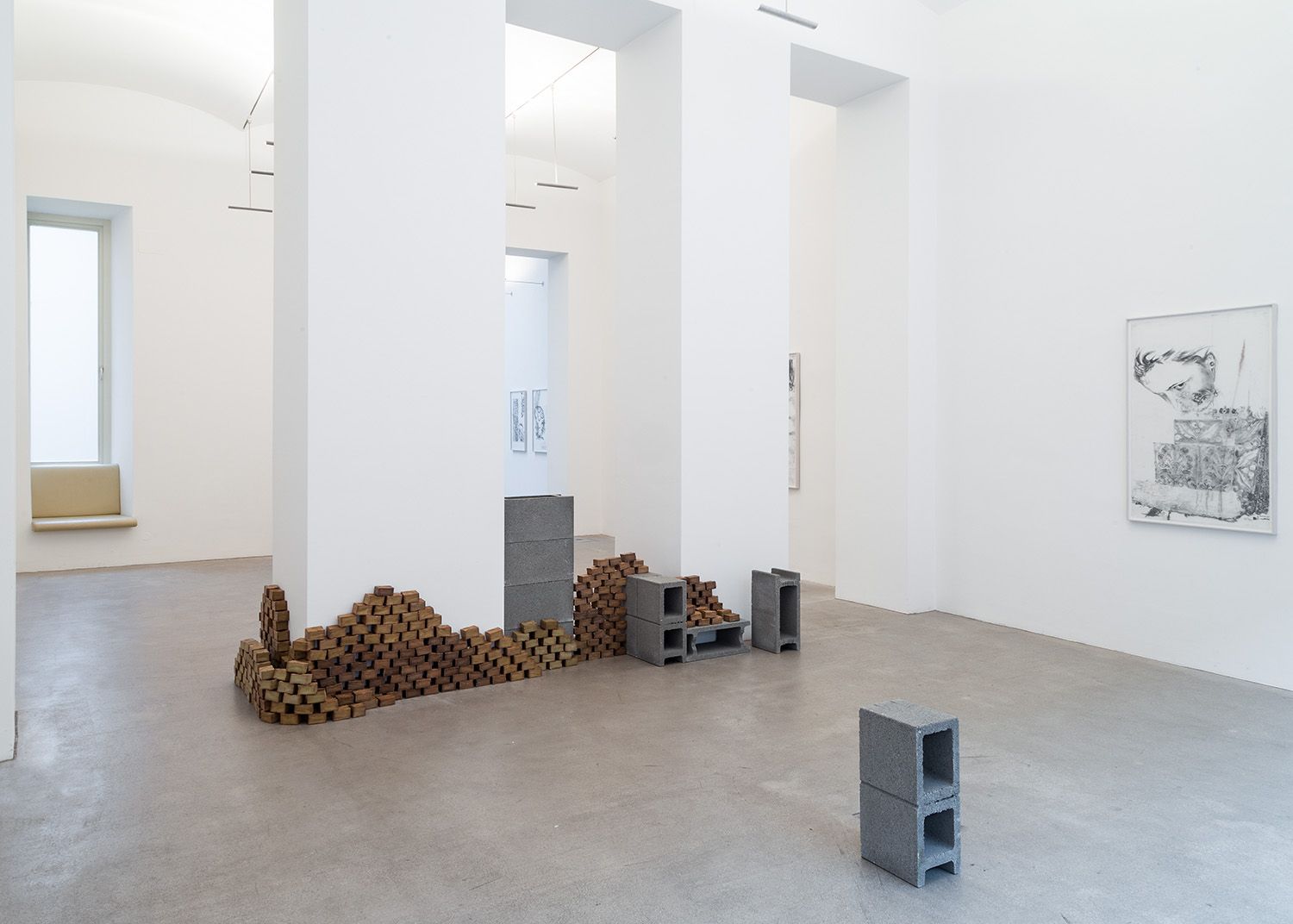ORDINAIRE BLAU
IRIS ANDRASCHEK is showing a series of drawings at Galerie Raum mit Licht for the European Month of Photography that circle around the possibility of accurately representing reality — or the impossibility of doing so. Fine-lined renditions of striking faces and heads are meticulously and realistically, as it were, drawn on semi-opaque foil. The artist has emphasised the subjects’ distinctive features with lettering or patterns, so concealing the original faces. On a second drawing of each on another sheet, she lays the heads around a dense, delicately worked mesh of ornaments and arabesques, in the stylised foliage of which sentences from conversations with those portrayed are interwoven. This process of covering/revealing is repeated in a number of photographs. The photographs also have embroidered raw silk cloths tacked onto them, as do some of the drawings on display.
The portrait drawings and the photos show people who have fled to Turkey from Aleppo, as well as their current surroundings. Iris Andraschek has developed her exhibition project on the basis of their history.
ORDINARY BLUE
Soap from Aleppo, of strangely archaic beauty — simple grey-green blocks, visibly shaped by the hand-manufacturing process, each embossed with an interlaced stamp, stand in the gallery stacked in a small pyramid. Iris Andraschek had travelled on an impulse from Istanbul to the Syrian-Turkish border in the spring of 2016 to meet the bearer’s of a 1000-year tradition of soap manufacture who had fled from Aleppo, and to follow the production process.
In Raum II of the gallery, documentary video footage shows the glowing, green colour of the still fresh raw materials and the delicate manufacturing process. The soap made of olive oil, laurel oil and soda represents an invaluable cultural asset, and the resumption of the manufacturing process while tentatively in safety means shaking off a little of the torpidity from the devastation of the war.
Iris Andraschek frequently takes the concrete reality of a situation as the basis for her work. Here, this is an endlessly complicated political situation, war, a great deal of personal suffering and very provisional manufacturing conditions.
The small fragments of mosaic allude to the annihilation of cultural identity. They represent valuable mosaics looted from Hama and now irretrievable as stolen goods: for the satisfaction of unbridled consumer greed.
In fact, fleeing and persecution often contribute to the transfer of cultural memes and artistic forms of expression, inevitably changing elements of them. This also applies all the more for the appropriation of “exotic beauty”; the fascination of the Orient has always been loaded with misapprehensions. This is exemplified by the transformation of a Ming Dynasty Chinese pomegranate and peach motif from the famous tiles of Iznik introduced to the Ottoman Empire into a well-known pattern on Meissen porcelain. It is now the Blue Onion Pattern (known in German as “ordinary blue”) that Iris Andraschek chose out of her interest in the art of ornamentation, and for the title of the exhibition.
The arabesque, stylised foliage, has been developed to the level of virtuosity since antiquity in the cultures of the Near East, with mathematical precision and in endless variations. As foliage they are always sprou-ting new shoots, as a graphic pattern or abstracted Garden of Eden it has neither a beginning nor an end and never merely “bewegtes Beiwerk” (an active appendage). As depictions of sentient beings is proscribed under Islam, the ornamentation of Oriental cultures is imposing for its depth and in the development of an indirect art of depiction. This embraces all fields of artistic expression, from calligraphy and poetry to the art of building, presenting the name of Allah for contemplation in every tile. Since Philipp Otto Runge, ornamentation in European art also emphasises the gaps, the not-shown in the image.
Iris Andraschek now uses this quality of indirect depiction to portrait the people she encountered on her travels. She was able to be present during the alchemical process of manufacturing soap, and she was able to talk with the workers who had fled the destruction of their homeland with their families. The artist has captured the faces of those she spoke to in delicate drawings on semi-opaque plastic foil. They look marked by their experiences, in addition patterns and lettering are superimposed on their features like camouflage. The artist then adds a further layer of milky paper over these drawings, marked with a profusion of orna-ments and tendrils. The all-over ornamentation binds the isolated heads in one pictorial surface, emphasises their non-illusionistic depth and simultaneously fragments the depiction. Furthermore, some sheets have embroidered scraps of raw silk tacked onto them. (The artist builds here on her process with photography where her distortion filters, for example, serve to emphasise the unity of the pictorial surface by challenging such unity and visually circumventing it.)
Iris Andraschek inserts sentences and snatches of conversation from the interviews into the ornamentation of the arabesque, for us legible in English but concealed as further shoots in the foliage. Incorporating the function of the calligraphy, an attempt is being made here to lend graphic form to the undepictable. Violence begets speechlessness, lending shape to the overawing terror means taking a step out of the torpor.
The soap from Aleppo is named after the oil of the laurel, Daphne, which is also the name of the mythologi-cal Greek female nymph who only managed to escape Apollo, the god of a new era, by transforming herself. This is described in Ovid:
“O father, help! if your waters hold divinity; change and destroy this beauty by which I pleased o’er well.” Scarce had she thus prayed when a down-dragging numbness seized her limbs, and her soft sides were begirt with thin bark. Her hair was changed to leaves, her arms to branches. Her feet, but now so swift, grew fast in sluggish roots, and her head was now but a tree’s top. Her gleaming beauty alone remained.
Metamorphoses, Book 1Text: Daniela Hölzl
